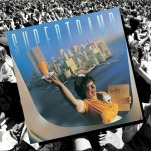Sorry, Timothée Chalamet, size is the real star of Dune
The scale and scope of Denis Villeneuve’s Dune is the steak and the sizzle

“Size does matter,” insisted the posters for Roland Emmerich’s 1998 crack at Godzilla. Unfortunately, his version of the King of the Monsters could barely be picked out among the film’s torrential downpours and towering New York City skyscrapers. Size mattered, and Godzilla failed to meet the height requirements. Denis Villeneuve’s Dune makes no such mistake.
Dune is a big movie with a big cast based on a big book with big ideas. While some of those ideas might have been lost in the journey from page to screen, the finished project certainly doesn’t lack for grandeur. Size is the sales pitch—the reason audiences are risking COVID to see the thing in theaters. In that regard, Dune is a success, using scale to surprise and delight audiences and reveal the film’s thematic concerns through sheer enormousness.
The eyes of Paul Atreides
Paul Atreides (Timothée Chalamet) is our guide through the world of Dune: Part 1. The wispy Chalamet makes for a good vantage point in this respect. He looks like he might blow away just perceiving the world around him.
This approach is not new to Dune cinematographer Greig Fraser, who brought a real sense of scale to Rogue One: A Star Wars Story. Rogue One director Gareth Edwards, who made a Godzilla movie where size actually mattered in 2014, knew how to shoot and frame ships in relationship to the much bigger Death Star. It’s a Star Wars tradition that filmmakers headed for the galaxy far, far away sometimes neglect. From its opening and arguably most famous shot, Star Wars aimed to show how small the rebellion stood next to the Galactic Empire. Dune operates in a similar way.
In Dune, scale is measured against Paul Atreides, who looks minuscule compared to the creatures and ships around him. This is by design. In an interview with The Hollywood Reporter, Fraser said that shooting the movie from Paul’s point of view was essential to its look. “Our approach was very much to be with this boy, to be at his height, in his head, to see the world through his eyes.”
Shot on IMAX cameras, the film bounces between 1.43:1 and 1.90:1 aspect ratios, favoring the height instead of the width of the frame. “[Villeneuve] dreamed his film in 4:3 [aspect ratio], which initially was an unusual thing to hear because 4:3 doesn’t immediately make me think of a big epic,” Fraser told The Hollywood Reporter. “But when I saw how we were shooting it for IMAX, I saw Dune how Denis saw it. The story is big. It’s epic. You can’t really get bigger from a scale perspective. But ultimately, it’s about this boy, Paul Atreides [and] about Paul’s journey with his family… We had to view the world from Paul’s eyes.”
Dune’s nesting-doll approach to scale
Dune goes out of its way to keep surprising the viewer with its scale, contracting and expanding from shot to shot. In one sequence, Paul; his father, Duke Leto Atreides (Oscar Isaac); and an accompanying crew take their ornithopter over to a malfunctioning Spice harvester before an oncoming sandworm can devour the machine and its workers. When one massive ship, a futuristic sphere known as a Carryall, fails to airlift the harvester to safety, Leto orders them to fly over and evacuate the workers themselves.
In this sequence, Villeneuve and Dune editor Joe Walker cut back and forth from closeups of the harvester and Carryall to wide shots of the two ships against the backdrop of the seemingly endless desert of Arrakis. First, we see the ships in relation to each other and then the ships against the landscape. The ships are undoubtedly immense, but compared to the actual dunes of Dune, they’re pretty small.





![Rob Reiner's son booked for murder amid homicide investigation [Updated]](https://img.pastemagazine.com/wp-content/avuploads/2025/12/15131025/MixCollage-15-Dec-2025-01-10-PM-9121.jpg)

























![HBO teases new Euphoria, Larry David, and much more in 2026 sizzle reel [Updated]](https://img.pastemagazine.com/wp-content/avuploads/2025/12/12100344/MixCollage-12-Dec-2025-09-56-AM-9137.jpg)








